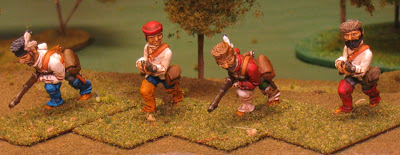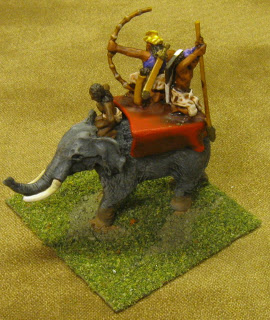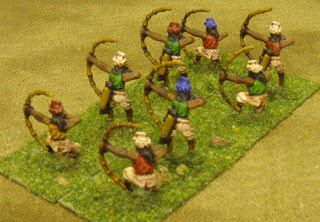As I said in my earlier post, I decided to base the rules for the Jumonville scenario on the Blood and Swash ruleset. However, there were some potential problems I wanted to address, and playtesting revealed some real problems to go along with the theoretical ones. The changes are significant enough that I think it’s safer to call the rules “inspired by” Blood and Swash and not based on them.
Blood and Swash uses a card-based activation system. Each turn, the game master draws one card from a standard deck of cards. If a black card is drawn, each player on one team activates a figure; if it’s red, the other team activates. Actions are moving, fighting, shooting, and “anything else you can think of,” in the basic game. Each character has attributes for its ability to shoot, fight, and so on. To see if your action succeeds, roll a 20 sided die: if it’s less than or equal to your applicable skill, you succeed.
The rules were written for pirate battles in a small, confied space. They emphasize doing creative things with the props available in the room, like rolling barrels of beer at the opponent or pulling the rug out from under their feet. The tight space compared to the number of figures makes the game fast paced and chaotic.
In order to emphasize this interesting chaos, guns are powerful but very slow. Reloading your gun might take 5 or more cards, and you can’t do anything else in the mean time. This might be okay in a bar fight, but in a shooting war it’s incredibly boring. The first change I knew I needed to make was to reduce the reload time; in fact, I got rid of reloading completely in the end.
Another aspect of Blood and Swash is that each player rolls dice to determine his figures’ skills at the start of the game. Players might end up crippled by one bad die roll at the start of the game. In a bar fight, this matters less: you can always punch someone if you’re no good at shooting. But the number of useful skills in a shooting skirmish is lower. I also wanted to reduce the game startup time, so I am predetermining each figure’s skills based on how the people acted in this specific skirmish historically.
Blood and Swash figures have a variable number of hit points, weapons have variable damage, and the skill checks use a “roll to succeed, the opponent rolls to prevent it” mechanic. Since the assortment of weapons is very limited compared to a pirate battle, I simplified this: all figures get 3 hit points, and each hit (shooting or hand-to-hand combat) does one point of damage. I adjusted the skill numbers to take into account the chance of an opponent preventing the action, to reduce the amount of die rolling.
In playtesting, I found what I feared: everyone walks within shooting range, starts shooting, and then there’s no incentive to ever move around. Without a rule to allow moving and shooting in the same action, static defenders get a huge bonus: they can often shoot first and can concentrate their fire on fewer figures within range.
To compensate, I added a new skill: Bravery. Whenever someone shoots at you, charges into combat, or charges into combat at you, you need to make a bravery check. If you fail, you run away (a full move away from the enemy, or at least moving out of line of sight). I also added a “move and shoot” action with a penalty to hit.
This made a huge difference: the game was no longer a static shooting match; instead, people were moving around a lot, like in the Pirate games.
To be fair: this rule system is not based on reality whatsoever. It’s intended to provide a fast, easy, fun, and hectic shooting skirmish.
The Rules: Skirmish at Jumonville Glen
By Alan Ferrency, 2009.
Figures and Skills
This is a skirmish scale miniatures wargame intended for 2 or more players controlling no more than 4 individually based figures each. It is not based on reality whatsoever, it’s just a game.
Players are divided into two teams: Red and Black.
Figures have several skills:
- Shooting determines how likely the figure is to hit another figure when shooting
- Fighting is how likely the figure is to hit another figure in hand-to-hand combat
- Bravery determines how likely the figure is to get scared and run away
- Save is the figure’s ability to take advantage of cover to avoid being shot
Each figure’s skills have a value from 1 to 20. To make a skill test for a specific skill, roll d20; the test succeeds if the result is less than or equal to the skill being tested.
Terrain and figures are deployed appropriately for the scenario being played. Enemies must start the game outside shooting range (12″) from each other. The game ends when one side has obviously lost (or no one is having fun anymore).
Turn Sequence
Each turn, one card is drawn from the top of a standard deck of playing cards. If it is Red, then all players on the Red team activate one of their figures. If it is Black, then all players on the Black team activate one figure. If a face card is drawn, each player on the appropriate team activates two different figures instead of one. (Note that each team might get multiple turns in a row, there is no problem with this.)
When a figure is activated, it can perform one of these actions:
- Move up to 6″
- Shoot at a figure within 12″ range
- Move and then shoot
- Charge at another figure up to 6″ away
- Fight a figure currently in base-to-base contact
Actions
Movement can be in any direction or around corners. Figure facing does not matter.
To Shoot at an enemy, the closest parts of each figure’s base must be no more than 12″ apart, and the figures must be able to see each other. The active figure makes a shooting test: roll d20; if it is less than the figure’s Shooting skill, they hit the enemy. If the enemy is hit, and they are in cover (hiding in the edge of trees or behind an obstacle), they make a Save test. A successful save means the shot hit the cover and not the figure.
Keep track of which figures are hit: when a figure is hit three times, it is removed from play.
After a figure is shot at, whether the shot hits or misses, they must make a Bravery test. If the test succeeds, nothing happens. On failure, the figure must immediately move away from the enemy that shot them, either 6″ or until the figure is out of line of site of the shooter.
If a figure Moves and Shoots, they must move first and then shoot. The figure’s shooting skill is -2 for the shooting test when it moves before shooting.
In order to contact an enemy figure to fight them, a figure must Charge. Before charging, the active figure must pass a bravery test. If the test fails, the figure can’t move or shoot but still counts as activated this turn. The figure being charged must also make a bravery test. If this test fails, the charging figure moves 6″ towards the charged figure, and the charged figure runs 6″ away as well.
A figure that successfully charges also Fights on the same turn they charge, and receives a +4 to their fighting skill. To fight, the figure makes a fighting test, and success means the other figure receives one hit. There is no save test when fighting, and fighting figures don’t make bravery tests. Figures that are in base to base contact cannot be shot at by either side.
That’s all there is!
Here is my current version of the figure stats for the Skirmish at Jumonville Glen.
- Virginians: shooting 8, fighting 8, bravery 12, save 10
- Indians: shooting 7, fighting 10, bravery 14, save 12
- French: shooting 8, fighting 8, bravery 10, save 10
I have half-page quick play sheets which we’ll use when actually playing the game. The rules are very simple in actual practice, but like all rules, understanding suffers when you read them without playing.
I’ve playtested this a few times by myself and once with Martine. It will work a lot better with only 2 figures per player, but even with me controlling all of the figures, I reached a decisive outcome within about an hour.


 These Indians are more of the Old Glory 25mm figures I painted earlier. For these, I tried to do most of the shading using a dark base coat and lighter highlights. I did the flesh and most of the colors this way, but I inked the white and tan leggings/moccasins.
These Indians are more of the Old Glory 25mm figures I painted earlier. For these, I tried to do most of the shading using a dark base coat and lighter highlights. I did the flesh and most of the colors this way, but I inked the white and tan leggings/moccasins. 















